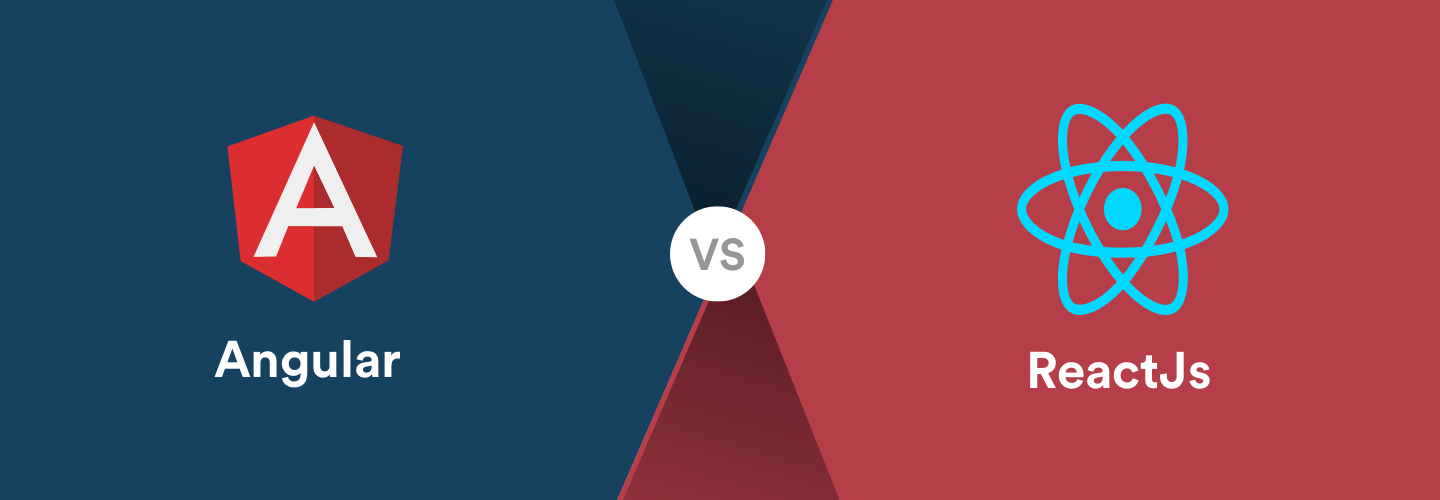Angular vs React: Which to Choose for Your Front End in 2024?
Compare Angular vs React for performance, maintainability, learning curve, and use cases to find out which one suits your needs better.


Tejas Kaneriya
February 10, 2023
8 mins read
Last Updated May 10, 2023

Some say comparing Angular and React is like comparing apples to oranges. Angular is a JavaScript framework built using TypeScript, while React is a JavaScript library built using JSX. Add a few libraries to React, and you can turn it into a complete framework. But the resulting stack workflow is still very different from Angular, so the comparability is limited.
It's common to compare Angular with React by comparing apples to oranges. The fundamentals of React, a JavaScript library created with JSX, and Angular, a JavaScript framework developed with TypeScript, are essentially different.
Even though React may be extended with more libraries to build a more complete framework, its stack methodology is still different from Angular's.
Notwithstanding these distinctions, component-based architecture is a feature shared by Angular and React, allowing for the development of reusable and modular components meant to address related front-end problems. As a result, the developer community is still debating between Angular and React.
So which one is the best? This article compares Angular vs React in-depth on a number of different dimensions, giving you the ability to determine which framework best fits the needs of your project.
With Simform is a leading, web app development company web app development company that specializes in creating scalable, forward-thinking apps using the best tech stack and contemporary frameworks. Our team of development specialists is prepared to work with you to analyze the scope of your project and determine the best course of action if you're having trouble making technological decisions. Get in touch with us right now to start your development process.
What is Angular?
Built on TypeScript, Angular is an all-in-one development platform and application-design framework with a component-based architecture for creating scalable online apps. Angular speeds up frontend development with its set of well-integrated frameworks and features, including routing and client-server communication. Its toolbox has a variety of developer tools designed for projects of different sizes, ranging from personal to enterprise-level software.
Originating from the same group of Google engineers, Angular is a total rewrite of AngularJS, which is no longer in use. It has a large developer community and receives frequent upgrades.
Some key differences between React and Angular are as follows:
1. Bidirectional data binding
2. Injecting dependencies
3. Scrolling virtually; 4. Angular CLI
5. Integrated libraries
Angular's benefits include:
1. Robust encapsulation and easily navigable application framework
2. Encouraging clean code development 3. Streamlining the processes for development, maintenance, testing, and updating
4. Built-in functionality such as AngularCLI and RxJS
5. Support for Observables, AJAX, and HTTP natively
6. Faster server-side content rendering;
7. Assistance for views without browser-side rendering;/,br> 8. Fewer code lines because of concurrent component execution; and
9. Enhanced developer efficiency
10. Better overall performance of the application.
What is React?
An open-source JavaScript library called React was created especially for front-end web development, particularly for creating user interface components. Because of its declarative views and component-based architecture, developers can easily create complex and interactive user interfaces. The "learn once, write anywhere" philosophy enables programmers to create scalable, quick apps for a range of platforms. Facebook's React team is in charge of React, which has a sizable and vibrant development community at its disposal.
Important characteristics that set React apart from Angular are:
1. Declarative opinions
2. The benefit of JSX
3. Digital DOM
4. Data binding in one direction
5. Modularity in the building elements
Benefits of React include:
1. Code that is more predictable and reusable
2. Debugging made easier with declarative views
3. Quicker time to development
4. Enhanced productivity of developers
5. Smooth transitions between various versions
6. React Native support for developing mobile apps
7. Quick updates that enable front-end and server-side functionality
8. Improved performance and load times with well-designed user interface elements
9. Capabilities for integrating with external libraries
Detailed comparison: Angular vs React
Now let's compare Angular and React in more detail.
Detailed Comparison: React vs. Angular
Popularity: In the developer community, Angular and React have both achieved considerable popularity. But which framework is the most popular of them all?
On GitHub, React has 203k stars, and Angular has 86.7k stars. These numbers show that both frameworks have a sizable fan base. React came in second place and Angular came in fifth place in a 2022 Statista study on the most popular web frameworks worldwide.
Angular: First appearing as AngularJS in the early 2010s, Angular gained popularity quickly, especially for building single-page applications (SPAs). As it developed, AngularJS had a total makeover with the release of Angular 2 in 2016, which included a number of new features and improvements. Since then, Angular has kept developing and improving its features.

React : this comparison, React stands out as the obvious winner, continually maintaining popularity levels higher than Angular. Rendering improvements, virtual DOM implementation, and version transfer that is seamless are some of its main benefits. React also does a great job at providing simple ways to reuse UI components, which greatly simplifies development duties. React is becoming the go-to JavaScript front-end framework for creating dynamic web apps because of these and other features.

Performance: Angular vs React
Angular and React are two distinct tools for creating web applications with great performance. However, which framework is the fastest and most effective?
Angular: Angular is excellent at streamlining code to continuously improve performance. It offers tools to improve code structures and speed up the digest cycle, making it easier to monitor and fix loops as codebases for new modules are developed. Older versions of Angular can be used to drastically reduce complexity for projects that do not require two-way data binding. The $cacheFactory feature of Angular improves memorization and speeds up data recalculation. Furthermore, Angular speeds up web apps by using real DOM for page rendering in conjunction with a special change detection technique and zones.
React: React makes use of a virtual DOM, a unique component that
Data binding: Angular vs React
The main difference between React and Angular is how they handle state management. React is primarily dependent on state management libraries, including Helmet and React Router, while Angular has data-binding built in. The Redux library is frequently used in React to enable working with immutable data and unidirectional data flow. So which strategy is better? With Angular, modifications to the model state immediately flow to interface elements and vice versa. This is achieved through the use of two-way data binding. By maintaining synchronization, the same data is continuously updated in both layers. Through the direct binding of HTML elements to model variables, Angular is able to manipulate and display data on the backend. The framework's two data models function in perfect harmony to allow for the development of interactive user interfaces.

